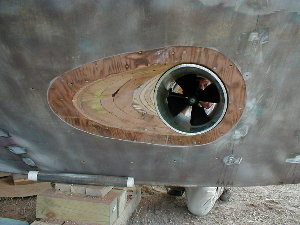Restoration
March 13, 2001
The winds of March showed up and ripped the Cherokee facility’s doors right off! Took quite a bit of plastic away, as well. That’s the downside of being perched right on the water, as any homeowner will tell you – the mosquitoes are kept at bay, but it often feels like you’re living out the scene in Dr. Zivago when they’re trudging across the windswept plains. Undaunted, the crew has patched things up, and continues the restoration. John, Jeanette, and Bill Brown have made much progress with the bow thruster installation.

John Cutting the Thruster Holes with Jeannette’s Guidance
Jeanette reports that it was both exciting and unnerving to cut two big holes in the hull. “From outside, the angle looked strange. But when you think about the shape of the hull in relation to the shape of the thruster, it makes sense. It all fit together perfectly, although I was a little nervous at first.”

The Flip Side of the Thruster Project
John is sculpting the faring areas so water will flow over the hole in the appropriate manner. He also fabricated the motor stand, and mounted the motor and gear box in the tube. The bow thruster itself is made of GRP, or glass-reinforced plastic. The crew cut the thruster tube and are now in the process of fitting it.


John Fitting the Propeller System into Bow Thruster Tunnel

Interior View of Bow Thruster, Thruster Tube, and Hull Reinforcement
Leonard and crew have continued work on Cherokee’s stern. They’ve scarfed and glued transom frames and sister pieces. The engine room looks clean and clear, since the staging, scaffolding, and Spanish Windlass were disassembled. The picture below not only shows Leonard grinding away in the engine room, but also the three original layers of plywood making up the hull along with the recently constructed backing board.

Port Stern of Cherokee

Symmetrical View of Leonard and Bill Davis at the Stern
Bill Brown is busy working on the vessel’s plumbing and waste system. He is also working on the anti-vibration mounts of the engines. He was amazed to find a face appear on the transom framing (as seen below). Believing he was seeing things due to post-Mardi Gras stress syndrome, he simply ignored it and went back to his plumbing engineering.

Fashion Piece Pig
Knocking about in Pamlico Sound like so many floating Volkswagons are more sea turtles than anyone can remember! Big ones, small ones, barnacle and seaweed covered ones – turtles of all species have chosen the waters of North Carolina as their extended vacation spot. A hundred years ago, Captain Josh Lewis of Morehead City invented “turtle diving”. After spotting a turtle, he’d tie his boat to one leg, dive underwater, grab the turtle and point it upwards to a “shoaler spot”. Once he gained footing, he’d wrestle the turtle onto the boat and sell him at the market for up to $2.00. Luckily for the turtles this non-lucrative, labor-intensive market petered-out, but fishermen still have an interesting relationship to the big reptiles. They fitted their nets with Turtle Exluder Devices ten years ago in response to worries of scarcities, and now they’re looking at further restrictions because of the presence so many turtles. Some environmental groups think fishing should be shut down entirely to give the endangered species plenty of elbow (flipper?) room. On the other hand, excluder devices are working well – isn’t it better to maintain a healthy shrimp fishery and avoid depending on imports from countries with no turtle protective measures or with environmentally destructive shrimp ponds? Time to go eat a shrimp burger and ponder this a bit…Signing off for now, Barbara “Fish Doctor” Blake








